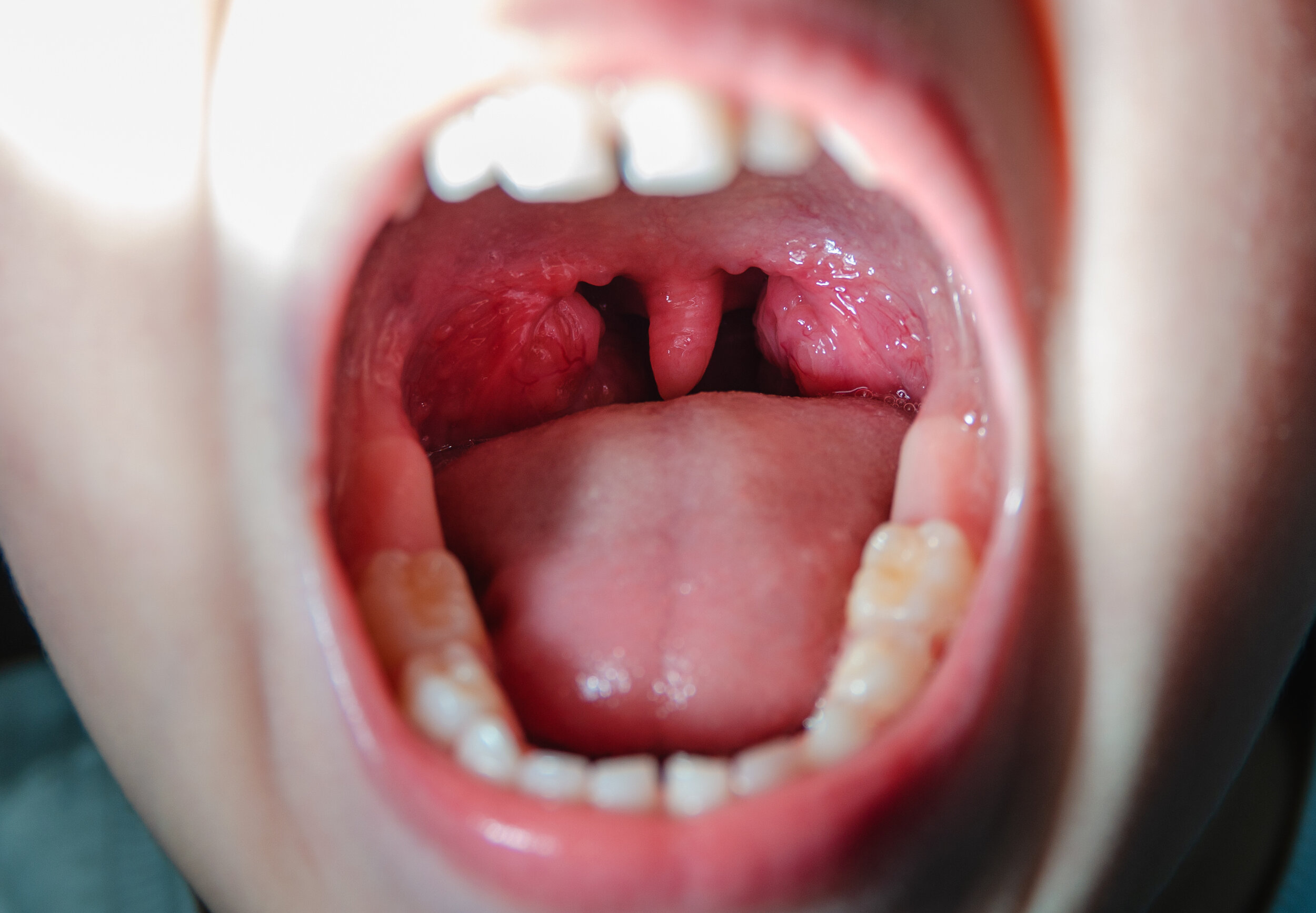What is tonsillitis?
Tonsils depicted in red.
Tonsillitis is a condition characterized by the inflammation of the tonsils, which are the two mounds of tissue located at the back of the throat. The term pharyngitis has a broader meaning, indicating inflammation of the throat (pharynx), but since tonsils are part of the throat, a tonsillitis is a type of pharyngitis. Tonsillitis is usually associated with swelling of the tonsils and discomfort. Tonsillitis is typically caused by a viral or bacterial infection, and it most commonly affects children and teenagers. Along with sore throat, one commonly experiences painful swallowing, enlargement of the lymph nodes under the jaw, sometimes fever and sometimes bad breath.
Large tonsils occupying about half of the airway.
Viral Tonsillitis
Viral tonsillitis is inflammation of the tonsils caused by a viral infection. When a viral infection, such as the common cold or flu virus, invades the body, it can result in the inflammation of these tonsils. Viral tonsillitis is highly contagious and can spread easily through respiratory droplets or direct contact with an infected individual. Usually, viral tonsillitis resolves on its own within a week to ten days with rest, hydration, and over-the-counter pain relievers. One exception is viral Mononucleosis — a condition associated with severe tonsillitis caused by the Epstein Barr Virus; see below. However, in more severe cases or when followed by a bacterial superinfection, medical intervention may be necessary.
Bacterial Tonsillitis
Bacterial tonsillitis is inflammation of the tonsils caused by a bacterial infection.. The causative bacteria is often of the Streptococcus type, although other bacteria, such as Staphylococcus aureus and Haemophylus influenza (or others) may also be responsible. Bacterial tonsillitis is not as contagious as viral tonsillitis, but may be spread by contact. Since the vast majority of cases of pharyngitis or tonsillitis is caused by a viral infection, which typically resolves spontaneously after 7-10 days, a statistical approach informs us that a pharyngitis or tonsillitis that persists beyond 7-10 days has increased likelihood of being bacterial.
Tonsil stones (tonsilliths) are collections of food and debris in the surface crypts (or pits) of the tonsils. The burden of tonsil stones may range from minor (such as short-term mild discomfort or halitosis) to more severe, such as promoting a significant and/or longstanding bacterial tonsil infection.
Mononucleosis (“mono”)
Mononucleosis (properly termed infectious mononucleosis), is an infection usually caused by the Epstein–Barr virus (EBV). Much less commonly, other viruses, including cytomegalovirus, rubella, and others, can cause mononucleosis. Most people are infected by EBV as children, when the disease produces few or no symptoms. In young adults, the disease often results in fever, sore throat, enlarged lymph nodes in the neck, and tiredness. Most people recover in two to four weeks; however, feeling tired may last for months. The liver or spleen may also become swollen, and potential rupture of the spleen with abdominal trauma is the reason for restricting activities like contact sports in this situation.
Spread: Mononucleosis is primarily spread through saliva but can rarely be spread through semen or blood. Spread may occur by objects such as drinking glasses or toothbrushes or through a cough or sneeze. Those who are infected can spread the disease weeks before symptoms develop.
Diagnosis: Mono is primarily diagnosed based on the symptoms and can be confirmed with blood tests for specific antibodies. The monospot test (also known as the heterophile test) uses a blood sample from a finger stick or from a vein, and provides a rapid result for the presence of specific antibodies that develop after mononucleosis. The monospot test is still sometimes used for convenience, but generally not recommended due to poor accuracy. A more accurate test for mononucleosis is to assay for IgG and IgM immunoglobulins against EBV. A positive EBV IgG indicates a prior infection with EBV, and a positive EBV IgM indicates the presence of a current or very recent infection.
Prevention and Treatment: There is no vaccine for EBV yet. Infection can be prevented by not sharing personal items or saliva with an infected person. Mono generally improves without any specific treatment. Symptoms may be reduced by drinking enough fluids, getting sufficient rest, and taking pain medications such as acetaminophen and ibuprofen. If the tonsils become so swollen that breathing is impaired, corticosteroids (e.g. prednisone) may be used.
Epidemiology: Mononucleosis most commonly affects those between the ages of 15 to 24 years in the developed world, and younger in the developing world. In those between 16 and 20 it is the cause of about 8% of pharyngitis. About 45 out of 100,000 people develop infectious mono each year in the United States. Nearly 95% of people have had an EBV infection by the time they are adults.
Bacterial superinfection
A superinfection is a second infection superimposed on an earlier one, especially by a different microbe, that is resistant to the treatment being used against the first infection. In the pharynx, the most common scenario is when a virus causes pharyngitis, and then bacteria take advantage of one’s decreased defenses to set up a bacterial infection. This transition from one infection to another may be apparent by a change in symptoms, such as having a sore throat that is improving around day 3-5 but then worsens again thereafter.
Abscesses (including peritonsillar abscess, retropharyngeal abscess, and parapharyngeal abscess)
An abscess is a collection of infected pus. When this happens, one’s ability to resolve the infection is hindered because the pocket of pus has no blood flow within it, so blood vessels cannot deliver the weapons of the immune system or antibiotics to the center of the abscess. In the throat, a peritonsillar abscess is one between the back wall of the tonsil and the throat constricting muscles. A retropharyngeal abscess is roughly midline behind the muscles constricting the throat, and has the potential to expand downwards into the chest. A parapharyngeal abscess is in a deep pocket on a side of the neck near the carotid artery and internal jugular vein.
This page





